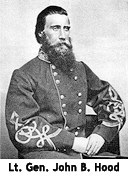|
Kentucky’s Civil War leaders...
Gen. Hood considered brave, aggressive;
but also reckless, which led to downfall
(EDITOR’S NOTE: This is the 26th in a series about Kentucky’s officers and battle leaders during the Civil War.)
 Confederate Lt. Gen. John Bell Hood had a reputation for bravery and aggressiveness that sometimes bordered on recklessness. Confederate Lt. Gen. John Bell Hood had a reputation for bravery and aggressiveness that sometimes bordered on recklessness.
Arguably one of the best brigade and division commanders in the Confederate Army, the Owingsville native became increasingly ineffective as he was promoted to lead larger, independent commands late in the war.
His career was marred by his decisive defeats in the Atlanta and the Franklin-Nashville Campaigns, which led to him being relieved of his command. He was decisively defeated at the Battle of Nashville by his former West Point instructor, Major Gen. George H. Thomas.
Hood resigned his U.S. commission in April 1861 to join the Confederacy as a cavalry captain, but soon was promoted to colonel of the Texas 4th Infantry. Thereafter he distinguished himself on a dozen fields, beginning in the Peninsula Campaign and at Second Manassas. At the Battle of Gaines’ Mill on June 27, he distinguished himself by leading his brigade in a charge that broke the Union line; this is arguably the most successful Confederate performance in the Seven Days Battles. While Hood escaped the battle without an injury, every officer in his brigade was killed or wounded.
Hood achieved his reputation for aggressive leadership during the Seven Days Battles, after which he was promoted to division command. He led a division under James Longstreet in the campaigns of 1862-63.
At the Battle of Gettysburg, Hood was severely wounded, rendering his left arm useless for the rest of his life. Transferred with many of Longstreet’s troops to the Western Theater, Hood led a massive assault into a gap in the Union line at the Battle of Chickamauga, but was wounded again, requiring the amputation of his right leg.
After the war, Hood moved to Louisiana and worked as a cotton broker and in the insurance business. His business was ruined by a yellow fever epidemic in New Orleans during the winter of 1878-79 and he succumbed to the disease himself, dying just days after his wife and oldest child, leaving 10 destitute orphans. The children were adopted by families in Louisiana, Mississippi, Georgia, Kentucky and New York.
The General married New Orleans native Anna Marie Hennen, with whom he fathered 11 children over 10 years, including three pairs of twins. He also served the community in numerous philanthropic endeavors, assisting in fundraising for orphans, widows and wounded soldiers. During the postwar period he wrote a memoir, Advance and Retreat: Personal Experiences in the United States and Confederate States Armies, which served to justify his actions, particularly in response to what he considered misleading or false accusations made by Joseph E. Johnston, and to unfavorable portrayals in W.T. Sherman’s memoirs.
|

